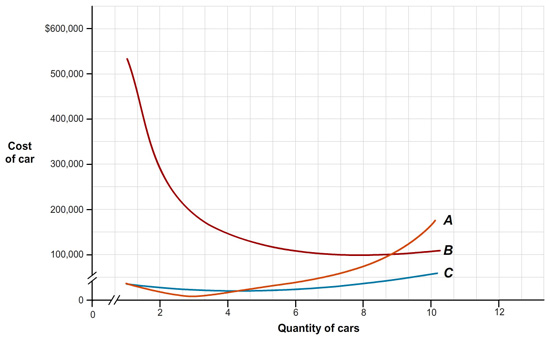Question 1 of 5
Step 1
The accompanying table shows a car manufacturer’s total cost of producing cars.
| Quantity of Cars | TC |
|---|---|
| 0 | $500,000 |
| 1 | 540,000 |
| 2 | 560,000 |
| 3 | 570,000 |
| 4 | 590,000 |
| 5 | 620,000 |
| 6 | 660,000 |
| 7 | 720,000 |
| 8 | 800,000 |
| 9 | 920,000 |
| 10 | 1,100,000 |
What is this manufacturer’s fixed cost?
Fixed cost: $
- Chapters
- descriptions off, selected
- captions settings, opens captions settings dialog
- captions off, selected
- English Captions
This is a modal window.
Beginning of dialog window. Escape will cancel and close the window.
End of dialog window.
This is a modal window. This modal can be closed by pressing the Escape key or activating the close button.
This is a modal window.
Step 2
Complete the table by calculating the variable cost (VC) for each level of output.
| Quantity of Cars | TC | Variable Cost (VC) |
|---|---|---|
| 0 | $500,000 | $ |
| 1 | 540,000 | $ |
| 2 | 560,000 | $ |
| 3 | 570,000 | $ |
| 4 | 590,000 | $ |
| 5 | 620,000 | $ |
| 6 | 660,000 | $ |
| 7 | 720,000 | $ |
| 8 | 800,000 | $ |
| 9 | 920,000 | $ |
| 10 | 1,100,000 | $ |
- Chapters
- descriptions off, selected
- captions settings, opens captions settings dialog
- captions off, selected
- English Captions
This is a modal window.
Beginning of dialog window. Escape will cancel and close the window.
End of dialog window.
This is a modal window. This modal can be closed by pressing the Escape key or activating the close button.
This is a modal window.
Step 3
Complete the table: for each level of output except zero output, calculate the average variable cost (AVC), average total cost (ATC), and average fixed cost (AFC) (please round your answer to the nearest whole number).
| Quantity of Cars | TC | Variable Cost (VC) | Average variable cost (AVC) | Average total cost (ATC) | Average fixed costs (AFC) |
|---|---|---|---|---|---|
| 0 | $500,000 | 0 | - | - | - |
| 1 | $540,000 | 40,000 | {{40000_40,000}} | {{540000_540,000}} | {{500000_500,000}} |
| 2 | 560,000 | 60,000 | {{30000_30,000}} | {{280000_280,000}} | {{250000_250,000}} |
| 3 | 570,000 | 70,000 | {{23333_23,333}} | {{190000_190,000}} | {{166667_166,667}} |
| 4 | 590,000 | 90,000 | {{22500_22,500}} | {{147500_147,500}} | {{125000_125,000}} |
| 5 | 620,000 | 120,000 | {{24000_24,000}} | {{124000_124,000}} | {{100000_100,000}} |
| 6 | 660,000 | 160,000 | {{26667_26,667}} | {{110000_110,000}} | {{83333_83,333}} |
| 7 | 720,000 | 220,000 | {{31429_31,429}} | {{102857_102,857}} | {{71429_71,429}} |
| 8 | 800,000 | 300,000 | {{37500_37,500}} | {{100000_100,000}} | {{62500_62,500}} |
| 9 | 920,000 | 420,000 | {{46667_46,667}} | {{102222_102,222}} | {{55556_55,556}} |
| 10 | 1,100,000 | 600,000 | {{60000_60,000}} | {{110000_110,000}} | {{50000_50,000}} |
- Chapters
- descriptions off, selected
- captions settings, opens captions settings dialog
- captions off, selected
- English Captions
This is a modal window.
Beginning of dialog window. Escape will cancel and close the window.
End of dialog window.
This is a modal window. This modal can be closed by pressing the Escape key or activating the close button.
This is a modal window.
Step 4
Complete the table by calculating the marginal cost (VC) for each level of output.
| Quantity of Cars | TC | Marginal Cost (MC) |
|---|---|---|
| 0 | $500,000 | - |
| 1 | 540,000 | |
| 2 | 560,000 | |
| 3 | 570,000 | |
| 4 | 590,000 | |
| 5 | 620,000 | |
| 6 | 660,000 | |
| 7 | 720,000 | |
| 8 | 800,000 | |
| 9 | 920,000 | |
| 10 | 1,100,000 |
- Chapters
- descriptions off, selected
- captions settings, opens captions settings dialog
- captions off, selected
- English Captions
This is a modal window.
Beginning of dialog window. Escape will cancel and close the window.
End of dialog window.
This is a modal window. This modal can be closed by pressing the Escape key or activating the close button.
This is a modal window.
Step 5
Label the manufacturer’s AVC, ATC, and MC curves.

Curve A is
Curve B is
Curve C is
- Chapters
- descriptions off, selected
- captions settings, opens captions settings dialog
- captions off, selected
- English Captions
This is a modal window.
Beginning of dialog window. Escape will cancel and close the window.
End of dialog window.
This is a modal window. This modal can be closed by pressing the Escape key or activating the close button.
This is a modal window.